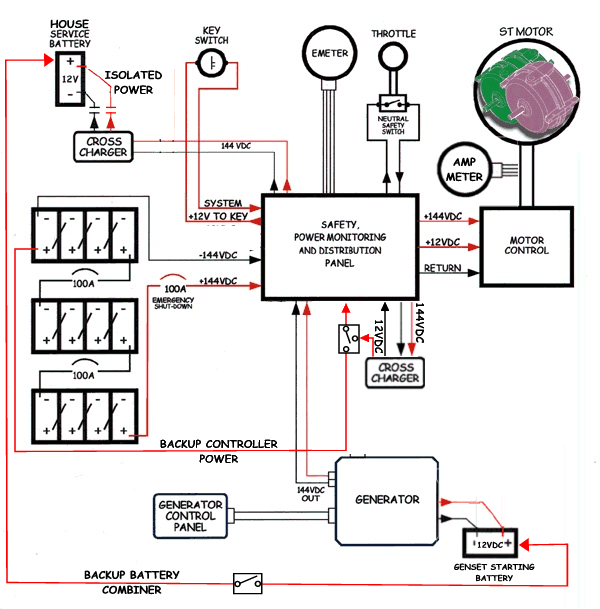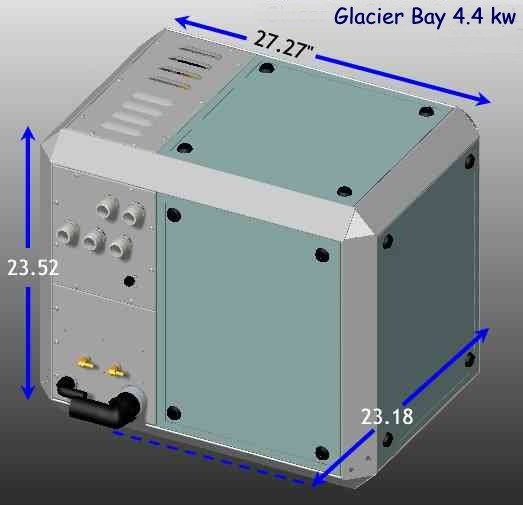
Prestissimo has a hybrid power plant. An electric motor drives the boat through a conventional shaft and propeller. Power is stored in a battery bank, and when sailing speed spins the prop faster than the rpm set by the throttle the motor generates power and charges the batteries. When sailing isn't an option, then a diesel generator can fully charge the batteries in a couple of hours. The batteries supply enough power for a couple of hours of motoring, but in practice, we usually turn on the generator if we anticipate motoring for more than 15 minutes.
The Solomon ST37 moves Prestissimo quietly through the water, but quiet is relative. You hear different things. The prop makes noise pushing against the water, and sometimes it "sings" when the harmonics are right. When you accelerate quickly the prop cavitates, and that makes a ripping sound. If it particularly still you can hear the hum of the motor, and if the generator is on, you can usually hear that. None of these sounds require that you raise your voice for conversation or disturb your sleep. In fact if we are motor sailing at a good clip with a nice breeze and the genset on we have to open the engine room hatch or check the instrumentation to see if the genset is still running.
The auxiliary motor is a Solomon Technologies ST37 with a maximum amp draw of 37 amps, and a rated horsepower of 6. Electric motors and diesel motors are rated differently, so this is supposed to equal a 24 hp diesel, but I think it is somewhat less. This motor drawing 37 amps in flat water with a 17 x 11 prop pushes Prestissimo along at just over 6 knots.
On the other hand, when I'm sailing at 6 knots I can generate about 5 amps (at 144VDC -- the equivalent of 60 amps at 12VDC). Even sailing at 4 knots I generate all the power I need to run electronics and refrigeration, and keep the house battery full. The prop drag appears to cost abut .1 knot of boat speed.

To power the electric motor I have a bank of 12 group 24 batteries rated at 80 amp hours. They are hooked together in series and separated with switches into four groups of 3 batteries, so that when the switches are open there is no more than 36VDC in the battery bank.
In addition the battery bank has a wire from each terminal pair that can be used to charge or test any one battery at a time. Sam Bickford and I designed a sequential charger to equalize the batteries in the bank by rotating the output from a shore charger to each battery for an hour at a time.
Why not skip the batteries all together, save 672 lbs and just use the genset if you are going to turn it on for most of your motoring needs anyway?
One thing I have discovered, however, if we want to save weight, a bank that just meets our house bank needs would probably suffice. I have rarely needed to run the motor on batteries alone for more than 20 minutes. A 400 amp hour bank and 80 amp hour house would still give us the advantages and save the 400 lbs as well.
| Group 24 - 80amp hrs 672 lbs size 11.13"L x 6.77"W x 9.25"H | 56 lbs ea. | ||||
| Discharge Rate | 4Amps | 8 Amps | 15 Amps | 25 Amps | 32 Amps |
| Total Battery Capacity (at discharge rate) |
80 AH | 70 AH | 65 AH | 62 AH | 60 AH |
| Hours to discharge to 12 V | 10.0 Hrs. | 4.4 Hrs. | 2.2 Hrs. | 1.2 Hrs. | .9 Hrs. |
| Hours to discharge to 10.5V | 20.0 Hrs. | 8.7 Hrs. | 4.3 Hrs. | 2.5 Hrs. | 1.9 Hrs. |
Glacier Bay designed the genset. It was designed as a 5.5 KW 144VDC generator, but it doesn produce more than 4.4KW without creating black carbon water exhaust. This is a problem that Glacier Bay is working on and expects to have solved in 2006. It has a convenient touch screen control panel with settings for voltage, maximum output, and auto start.
Even at reduced power the genset bulk charges the batteries in an hour, of course it takes a couple more hours to top them off as the acceptance drops. Of course sailing in a 10 knot breeze will do that very nicely.

The marine hybrid is in its infancy. Prestissimo uses the equipment that was available in 2004, and much of the "ease of use" features hadn't and in 2006 still haven't been released yet. We need to be pretty aware of what is going on to keep everything working efficiently. Basically we need to watch the batteries and and control the different stages of charging.
In discussions with both Glacier Bay and Solomon Technologies, both companies are well aware of this user difficulty, and both are working to solve these problems and make the marine hybrid system as convent as the automotive systems.